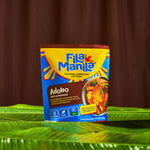

Filipino Adobo vs. Spanish Adobo: What’s the difference?
From Philippines to Fila Manila
By Patrick Kho, for Fila Manila
Adobo is a popular dish in the Philippines, and growing in popularity here in the US too. But other countries like Spain have an adobo dish of its own.
It’s easy to confuse either of these for one another — after all, the Philippines and Spain share a long history, with over 300 years of Spanish rule leading to cultural exchanges and mutual influences. Take, for instance, that the names of both dishes have the same root word, coming from the Spanish word “adobar,” which means to marinate.
So, what’s the difference between Filipino and Spanish adobo?
What is Filipino Adobo?
Filipino Adobo is made by stewing meat, seafood or vegetables in a mix of soy sauce, vinegar, and garlic.

In its most common form, adobo is cooked using chicken, usually drumsticks or thighs, to make Chicken Adobo. But it can also be cooked with pork, and some variations in the Philippines also cook the dish with seafood, like squid.
The dish’s taste comes primarily from the vinegar and soy sauce used in the braising liquid, so Filipino adobo balances salty, sour, and umami notes.
But while this is generally the sort of flavor you can expect from adobo, different families make the dish differently. Some families add sweeteners like date nectar. In every household or restaurant, adobo can taste differently.
What is Spanish Adobo?
Food & Wine describes Spanish adobo as “a long-marinated protein.” In Spain, adobo refers to the process of marinating raw protein in vinegar, spices, and aromatics — the most popular being pimentón, fresh garlic, and bay leaves. Wine and/or olive oil are often mixed into the marinade as well.

The meat marinates for a few days, and is then cooked. The result is a richly flavored protein, balancing spice with umami and sourness.
How are they different?
Comparing the two dishes side-by-side some differences are clear. Filipino adobo has more East Asian flavors and influences (notably from the use of soy sauce). And because the Filipino version has no wine or olive oil, its sauce tends to be thinner.
Spanish adobo, on the other hand, has more spice, and has a thicker sauce.
One difference to keep in mind is that while adobo can refer to similar cooking methods across countries, there are subtle differences in the meaning. One writer on Greatist notes “ ‘Adobo’ can refer to a seasoning, a sauce, or a whole dish,” depending on the country.
In most Latin cultures, adobo is more a form of cooking (or even a sauce/marination method) rather than the name of a dish itself. Many dishes are called adobado, which means cooked in an adobo sauce.
So while adobo refers to an exact dish with a particular recipe in the Philippines, adobo in Spain more so describes the sauce used to cook the meat.
How are they similar?
In both countries, adobo emerged as a cooking method to preserve food. In Spain, vinegar was used by early cooks to store and preserve meat during summer months, long before refrigeration was available.
The Philippines, a similar cooking method was used by the indigenous tribes. But when the Spanish Empire arrived in the Philippines in the 16th century, Spanish colonists noticed how similar the indigenous cooking technique was to their own adobo, and so they passed on the same name to the Filipino version.
Beyond their origins, they’re also similar in that they both use vinegar and aromatics like bay leaves!
Adobo in other countries
The Philippines and Spain aren’t the only countries with an adobo. Others include:
1. Mexico: Mexican adobo is a wet marinade, adapted after the Spanish conquest, using local ingredients like ancho and guajillo chilies instead of pimentón.
2. Puerto Rico: Puerto Rican adobo traditionally includes garlic, vinegar or citrus, oregano, salt, pepper, and olive oil. It preserves and flavors tougher meats, such as pork shoulder, or can be adjusted for delicate proteins like fish.
3. Peru: Peruvian adobo — or adobo de chancho — is a traditional pork stew from southern Peru, featuring ají panca paste and chicha de jora (corn beer). Typically served with rice and sweet potatoes, it offers a spicy and comforting flavor.
4. Uruguay: In Uruguay, adobo refers to a spice mix similar to the Spanish version, often used as a condiment.






